|
< Earlier Kibitzing · PAGE 2 OF 2 ·
Later Kibitzing> |
| Jul-18-10 | | ceebo: There is analysis of this endgame by Nunn here:
http://www.chessbase.com/newsdetail...
He says that with best play 34.g3 is only good enough for a draw (35...Kf5 would have allowed black to draw) and that 34.g4! should have been played instead. |
|
| Jul-18-10 | | darkjuva: insane? |
|
| Jul-18-10 | | tivrfoa: h5 is better, but I think that the idea to place the bishop at g5 also works. |
|
| Jul-18-10 | | C4gambit: For those who are novices like me, this game is a good opportunity to learn. This is what i thought when i saw the puzzle - "White is 2 pawns up but cannot make queen on a or b file because of the white bishop of black. So i need to take the king to the queen's side. I don't need to worry about the black pawn cause it cannot go past my pawn on h file." And then i tried to move my bishop and king in different combinations to get to the other side of the battle field. I even got a unique idea of preventing the black king to get to my pawn duo - by blocking the h2-b8 diagonal with my bishop and since black king cannot go to any square of h1-a8 diagonal (then i would queen the a pawn), he can't stop my king going near those pawns. But unfortunately the big idea failed and the black king went to the b7 square! This is what i should have thought - "Every time i want to move my king, i have to go backwards first, giving black king enough space to come forward and at the end my king cannot claim the queen side territories. And all these is because of that black pawn at g6. Without it, i could push my king to f5 and black king will have no passage towards the most important queen side. So i need to get rid of that black pawn. How? Well, by pushing the pawn i have on the h file." Chess is simple, i made it complicated by thinking the wrong way. |
|
| Jul-18-10 | | tivrfoa: 28. Bc5! is really nice indeed |
|
Jul-18-10
 | | OBIT: The Kasparov analysis seems to show Black still had a draw as late as move 35, but 27...Bc2? at minimum loses a second pawn, making the defense more difficult than it has to be. Instead, Black's blockade looks airtight if he plays 27...Bc4, as the queenside pawns keep the White king out. This is one of those situations where the standard advice "trade pawns but not pieces" when down material is not so good -- those extra pawns actually simplify the defense. |
|
| Jul-18-10 | | David2009: Euwe vs Yanofsky, 1946 White 45? 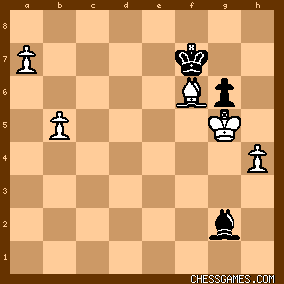
click for larger viewMissed it completely. I saw a beautiful win beginning 45.Bd8?? Ke8?? (45...Be4! draws) 46.Kxg6 Kxd8 47.Kf5 Kc7 48.h5 Kb7 49.h6 Bf1 50.Ke4 and Black (to play) cannot stop the Pawn. 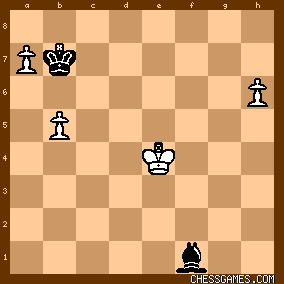
click for larger view
Unfortunately in this line the pedestrian 47.h5 wins just as easily, e.g. 47...Kc7 48.h6 Kb7 49.b6 Kxb6 50.h7 and Black's Bishop is overloaded.
After 45 Bd8? Be4 draws.
Crafty on-line link to the puzzle position: http://www.chessvideos.tv/endgame-t...
You are White: enjoy exploring the variations. |
|
| Jul-18-10 | | whiteshark: A classic! |
|
Jul-18-10
 | | al wazir: Euwe could have won this game in several ways. For example, he could have traded off black's last two ♙s, e.g., 37. Kg5 Be4 38. a8=Q Bxa8 39. Kxg6 Bf3 40. Kg5 Bg4 41. h3 Bxh3 42. Kxh5. (This line isn't unique, but white can always force the exchanges.) Now the position looks something like this:
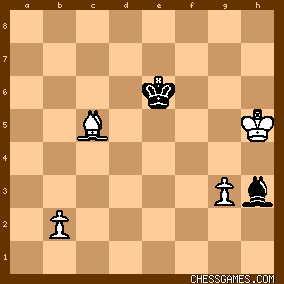
click for larger viewNext, white stations both ♙s on black squares and puts his ♗ where it can guard both. Black has to use his ♗ to block the advance of one ♙ and his ♔ to block the other. The white ♔ is mobile; it can swing from one side to the other. It moves to whichever ♙ the black ♗ is blocking and escorts that ♙ forward. Black has to give up the ♗ to stop it. At this point the material is ♔+♗+♙ vs. ♔, and the ♙ is on file b or g. Even patzers like me can win that ending. |
|
Jul-18-10
 | | Jimfromprovidence: I've been trying for a while to to find out if there is a draw possible with 41...Be4?!
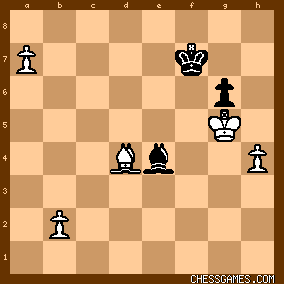
click for larger viewThe idea is for black to protect the g pawn with his bishop, freeing his king to go after white's 2 passed pawns, ultimately trading the g pawn for white's a or b pawn. It turns out that a draw is possible if white gives up his b pawn for the g pawn, such as in the position below, which is a table base draw.
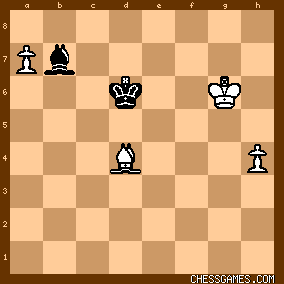
click for larger view
However, if white forces black to take his a pawn for the g pawn, such as in the position below, it is a table base win for white.
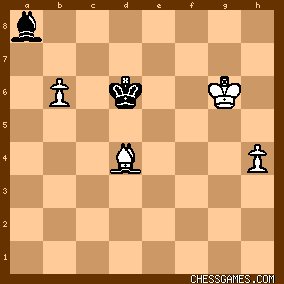
click for larger viewPlaying these two positions through the table bases, (link below) http://www.k4it.de/index.php?topic=...
it finally becomes obvious that even though the beginning positions are very similar, the opposition belongs to black in the first case and to white in the other. |
|
| Jul-18-10 | | AuN1: my endgame must be way better than my middle game because i got this one relatively easily while missing some of the earlier ones this week. |
|
| Jul-18-10 | | David2009: Jim, your posts are always instructive and in Euwe vs Yanofsky, 1946 the second of the diagrams you post 
click for larger view there is a simple explanation of why this position will be drawn. Provided that Black can reach b7 with his K in time, he can safely give up his B for White's h pawn. The White B is the wrong colour for the a Pawn to queen. So for this example the table base is not necessary. |
|
| Jul-18-10 | | wals: Black started to unravel from move
27...Bc2. +1.34. (Bc4 +0.66)
29...Bxe4.+1.92. (Ke6 +1.36)
36...g6. +2.92.
37...hxg4. +4.58. and never improved. ..
Rybka 3 1-cpu: depth 26: |
|
Jul-18-10
 | | Jimfromprovidence: <David2009> <...there is a simple explanation of why this position will be drawn.> <Provided that Black can reach b7 with his K in time, he can safely give up his B for White's h pawn. The White B is the wrong colour for the a Pawn to queen.So for this example the table base is not necessary.> No, not true in this case. This endgame stuff is scary complicated. (The below diagrams with white to play show this). Here's a final 1/2- 1/2 result derived from the "drawn" diagram you and I presented. 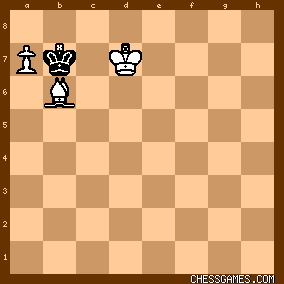
click for larger viewHere's a 1-0 result derived from the "winning" diagram I presented.
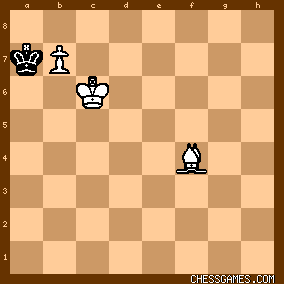
click for larger viewHas nothing to do with which color the bishop is, but everything to do with who has the opposition. |
|
| Jul-18-10 | | randomsac: Nice way to gain some space for the king. Now that I see the solution it seems so simple, but I had such a hard time finding it. |
|
| Jul-18-10 | | waustad: It's rare for me to see a Sunday one, but this one worked. |
|
| Jul-19-10 | | njchess: 45. h5 is the only move for a win. This is very easy puzzle and I seriously doubt Euwe missed this one. The key to this position is in understanding that the king closest to White's queenside pawns will dictate whether it is a win or a draw. |
|
| Jul-19-10 | | patzer2: <Formula7: 45.h5 and here 45...gxh5 loses because after 46.Kf5 the white king marches over to the queenside to make Black give up his bishop for the a-pawn, and then White promotes his b-pawn...> <lost in space: I think the easiest way to win for White is to bring his king quickly to the queenside of the board to suport the own 2 passed connected pawns...> These excellent posts sum up the winning idea behind yesterday's difficult Sunday puzzle position. The solution 45. h5!, which I missed by the way, seems simple and immediately clear after having read these posts. However, that's the way brilliant ideas or difficult solutions often work (i.e.they're hard to find or understand, but seem so simple once they're clearly explained). |
|
Mar-27-11
 | | plang: 4..d6 ts hardly ever played anymore although there is no refutation. It has some similarities to a system of the Pirc that Benjamin occasionally used with pawns on d6 and e6. 10..e4 could have been answered with 11 fxe..Bxe4 12 Rxf6!..gxf 13 Nxe4..Qxe4 14 Bf3 with a big advantage. 10..Nbd7 would have been more logical. Yanofsky's decision to give up a pawn to obtain opposite color bishops seemed reasonable and could have been enough to draw. It is hard to blame him for not seeing the pretty winning plan with 44 Bf6 and 45 h5. |
|
Mar-27-11
 | | beatgiant: <Jimfromprovidence> <Here's a 1-0 result derived from the "winning" diagram I presented.Has nothing to do with which color the bishop is, but everything to do with who has the opposition.> Your 1-0 example is not with a rook's pawn, which is why it's not relevant to <David2009>'s comment: <The White B is the wrong colour for the <<a>> Pawn to queen.> Hope this clarifies. |
|
| Jul-27-12 | | vinidivici: Poor Yanofsky.
35...Bg2 seems an error.
35...Kf5!!!!!!! will save the game to a draw.
U need your king to guard the white king to prevent him to get closer with the pawns. 36.Bf8 g6
37.Kd4 Bg2
38.Kc5 Ke6
39.Bb6 Kd7
40.b4 Ba8
41.b5 Kc8 draw.
In view 41...Bg2 black loses after
42.a=Q Bax8
43.Ka7 Bf3
44.Bb8.....b-pawn will queen and will cost the black bishop. (1-0) |
|
Aug-13-16
 | | dernier loup de T: After the 44th move.
The logical key: the king of White MUST absolutely pass on the case f5 without losing time, in order to force the decision by the promotion on a8; so, deviating the black g6 pawn is the ONLY way to reach this goal. |
|
| Apr-26-17 | | andrea volponi: 41...Ae4! -Kf4 Aa8 -Ke5 Ke7 -Ac5+ Kd8 -b4 Kd7 -b5 Kc8 -b6 Af3 -Kf6 Ae4 -a8=D Axa8 - Kxg6 Ae4+ -Kh6  . . |
|
| Apr-25-22 | | BentOuttaSmyslov: The St. Louis Chess Club has a nice lecture on this endgame given by GM Eric Hansen here: https://www.youtube.com/watch?v=SbV... |
|
Oct-15-23
 | | nizmo11: This is game 62 in Timman's book on Euwe.
Timman points out the winning move
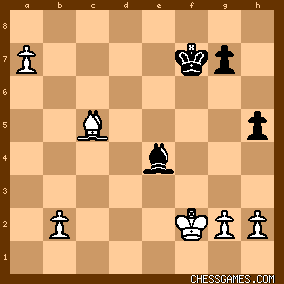
click for larger view34.g4!!, but then makes an strange comment (p 236) :
"There could have followed 34...hxg4 35.Kg3 Bf3 36.Kf4 Ke6 37.Bd4 g6 38.Kg5(??) Kf7(??) 39. b4 and the rest of the winning process is automatic."
Perhaps this comment got somehow garbled, as in final the position
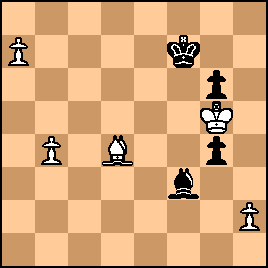
click for larger viewBlack draws with 39...g3, because White does not have the breaktrough h5!, and Kf5 that happened in the game.
The move 38. Kg5 is also an error that allows a draw with 38...Kd6/d7; Black's King reaches b7. After 38...Kf7? White could have repeated with 39.Kf4 Ke6, and then played the winning 40.h3! (or h4) followed by Kxg4 after the Bishop moves, or if 40.h3 Ke7 then 41.hxg4 and 40...Kd7 is too late: 42.Kf6 Be4 43.a8D |
|
 |
|
< Earlier Kibitzing · PAGE 2 OF 2 ·
Later Kibitzing> |





